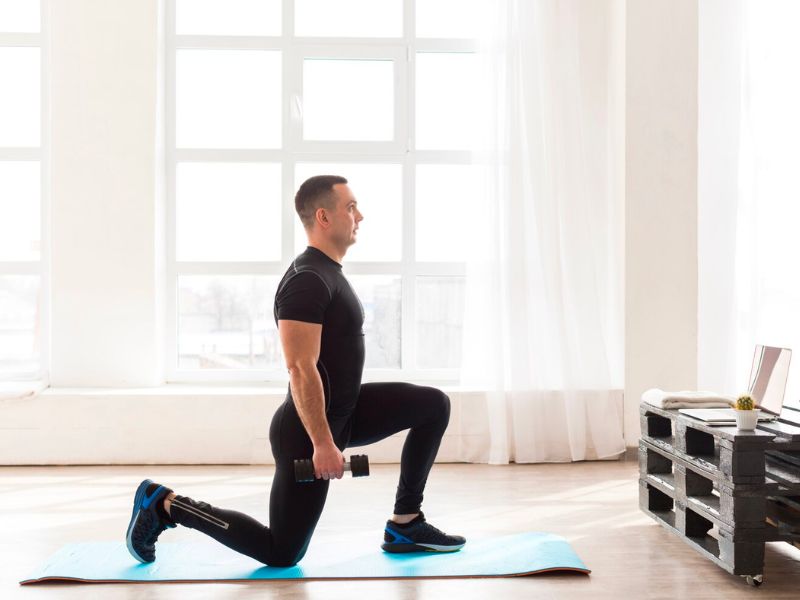Ever look in the mirror and wish your body felt a bit…firmer? Maybe you dream of keeping up with your energetic kids or tackling those stairs without getting winded. You’re not alone.
A whopping 60% of adults report feeling dissatisfied with their bodies, according to a recent study by the American College of Sports Medicine (*). But what if there was a secret weapon to feeling stronger, more confident, and even happier? Enter strength training.
Strength training might seem intimidating, especially for beginners. Images of bulky bodybuilders or clanking weights can make anyone feel out of place.
But here’s the truth: strength training is for EVERYONE.
Think about it this way: imagine yourself effortlessly carrying groceries, chasing after your pet, or simply feeling more confident in your own skin. Strength training can be your key to unlocking a stronger, healthier you.
Here’s the good news: you don’t need a fancy gym membership or expensive equipment to get started. This guide will equip you with the essential knowledge to embark on a safe and effective strength training journey, right from the comfort of your home.
Getting Started: Your First Step Towards Strength training

Strength training can seem intimidating at first, but with the right approach, it’s accessible and rewarding. Here’s what you need to know to get started:
- Find Your Gear: Free weights, resistance bands, even your own bodyweight can be your tools. Explore options that fit your budget and preference. Certified personal trainer Rachel Cosgrove emphasizes, “The best equipment is the one you’ll actually use.”
- Warm Up Like a Champion: Dedicate 5-10 minutes to light cardio (think brisk walk) and dynamic stretches to prep your muscles for action. Imagine warming up your car engine before hitting the road – it’s just as important for your body.
- Cool Down and Recover: After your workout, dedicate 5-10 minutes to static stretches to improve flexibility and reduce muscle soreness. Think of it as giving your muscles a big hug after a great workout.
Mastering Essential Techniques

Building a strong foundation in proper technique is crucial for maximizing results and preventing injury.
- Focus on Flawless Form: This is key to maximizing results and preventing injury. Don’t be afraid to start light and prioritize proper movement over heavy weights. Consider working with a trainer or following online tutorials by experts like Bret Contreras, known as the “Glute Guy,” who emphasizes proper form for exercises that target your glutes.
- Slow and Steady Wins the Race: Maintain a controlled pace, lifting and lowering the weights slowly for optimal muscle engagement. Picture yourself lifting a glass of water with perfect posture – that’s the kind of control you want.
- Breathe Easy, Move Easy: Breathe out during the exertion phase of the exercise (when lifting the weight) and inhale during the release. Proper breathing helps stabilize your core and improves exercise efficiency.
- Progressive Overload: Your Muscles Crave a Challenge. Gradually increase weight, sets, or repetitions over time to keep challenging your muscles and promote ongoing progress. Imagine climbing a ladder – you wouldn’t stay on the first rung forever, would you?
Building a Powerful Routine

Consistency is key to reaping the benefits of strength training. Here’s how to structure your workouts:
- Train 2-3 Times a Week: Aim for 2-3 strength training sessions each week. This “sweet spot” helps your muscles grow and recover, according to the American Council on Exercise (*). Think of it like giving your muscles a targeted workout, followed by rest days to rebuild stronger.
- Listen to Your Body: Rest days are your friend. Schedule at least 48 hours of rest between workouts for the same muscle group. Imagine your muscles as tiny factories – they need time to process the workout and build new muscle.
- Stress Less, Feel Better: Strength training isn’t just about looks. Studies show it can actually reduce stress and anxiety. This mind-body connection leads to a better mood and overall well-being.
- Start Simple, Get Stronger:
- Do 1-2 Sets of 8-12 Reps: This rep range (recommended by experts like fitness trainer Bret Contreras) helps build a strong foundation without getting injured. Think of it as laying the groundwork for a strong building.
- Gradually Increase Reps or Sets: As you get stronger, bump up the number of sets or reps you do. This keeps your muscles challenged and helps you keep progressing.
- Full-Body Workouts vs. Split Routines:
- Full-Body Power: Start with full-body workouts that hit all major muscle groups (legs, back, chest, core, arms, shoulders) each session. This is time-efficient and gives you a well-rounded base, just like popular fitness influencer Pamela Reif’s full-body routines.
- Split It Up Later: As you get more advanced, you can explore split routines (upper body/lower body) for more focused training.
Modifications for Different Needs

Strength training is an inclusive activity that can be adapted for various needs. Here’s how to ensure a safe and effective workout for everyone:
Limited Mobility or Injuries:
- Focus on bodyweight exercises or lighter weights: The American Council on Exercise (ACE) recommends prioritizing exercises that don’t aggravate the affected area. [*]
- Explore modifications: Consider seated exercises, using resistance bands instead of free weights (easier on joints), or focusing on upper body if lower body limitations exist.
- Scientific evidence: A study published in the Journal of Strength and Conditioning Research found that bodyweight exercises can be just as effective as weighted exercises for building muscle strength in healthy adults (*), especially for beginners.
Pre-Existing Health Conditions:
- Consult your doctor first: This is crucial, especially with conditions like heart disease, diabetes, or arthritis. They can advise on safe exercises and weight limitations.
- Strength training benefits most conditions: Research from the American College of Sports Medicine (ACSM) highlights the positive impact of strength training on various health conditions, promoting better blood sugar control in diabetes and improving cardiovascular health. [*]
Pregnancy:
- Low-impact exercises are key: Prenatal yoga is a popular choice, as are modified bodyweight exercises focusing on upper body and core strength.
- Safety first: The American College of Obstetricians and Gynaecologists (ACOG) recommends avoiding exercises that strain the abdominal muscles or require lying on your back in the later stages of pregnancy. [*]
Postpartum Recovery:
- Listen to your body: Ease back into strength training gradually after childbirth.
- Start light: Focus on core and pelvic floor exercises to regain strength in these crucial areas. The Mayo Clinic emphasizes the importance of prioritizing pelvic floor exercises for postpartum recovery. [*]
- Increase weight gradually: As your body recovers, you can slowly increase the weight or resistance used in your workouts.
Age Considerations:
- Focus on balance, coordination, and bone density: Exercises like squats, lunges, and core work are excellent for improving these aspects as we age.
- Strength training helps prevent falls: A meta-analysis published in the Journal of the American Geriatrics Society found that strength training can significantly reduce the risk of falls in older adults. [*]
Fueling Your Journey: Nutrition

Diet plays a crucial role in supporting muscle growth and recovery, allowing you to optimize your strength training results. Here’s a breakdown of key nutrients:
- Protein: The building block of muscle. Aim for 0.8-1 gram of protein per pound of bodyweight daily, as recommended by the Academy of Nutrition and Dietetics. Lean meats, fish, eggs, dairy, beans, and lentils are excellent sources.
- Carbohydrates: Provide energy for your workouts. Choose complex carbs like whole grains, fruits, and vegetables for sustained energy release, which will help you power through your workouts.
- Healthy Fats: Essential for hormone regulation and nutrient absorption. Include healthy fats from sources like avocado, nuts, seeds, and olive oil in your diet.
- Hydration: Crucial for overall health and performance. Drink plenty of water throughout the day, especially before, during, and after workouts. The National Academies of Sciences, Engineering, and Medicine recommends consuming fluids to replace those lost through sweat during exercise.
Also Read:
Conclusion
Strength training might seem like the realm of bodybuilders, but it’s an accessible and rewarding journey for everyone, regardless of age, fitness level, or limitations. This guide equips you with the knowledge to get started safely and effectively, right at home.
Here are the key takeaways:
- Start with proper form: Focus on technique over heavy weights to avoid injury.
- Listen to your body: Train 2-3 times a week, incorporate rest days, and start light, gradually increasing weight or reps as you progress.
- Embrace modifications: Bodyweight exercises, lighter weights, and seated variations are great options for beginners or those with limitations.
- Fuel your body: Prioritize protein, complex carbs, healthy fats, and hydration for optimal results and recovery.
Remember, consistency is key. Embrace the process, celebrate small wins, and enjoy the journey to becoming a stronger, healthier you.


Hello Neat post Theres an issue together with your site in internet explorer would check this IE still is the marketplace chief and a large element of other folks will leave out your magnificent writing due to this problem
As someone who struggles with mental health, I appreciate the support and empathy displayed in your blog It means a lot to know I’m not alone